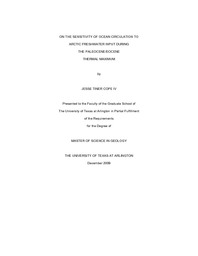
ATTENTION: The works hosted here are being migrated to a new repository that will consolidate resources, improve discoverability, and better show UTA's research impact on the global community. We will update authors as the migration progresses. Please see MavMatrix for more information.
Show simple item record
| dc.contributor.author | Cope, Jesse Tiner | en_US |
| dc.date.accessioned | 2010-03-03T23:30:28Z | |
| dc.date.available | 2010-03-03T23:30:28Z | |
| dc.date.issued | 2010-03-03T23:30:28Z | |
| dc.date.submitted | January 2009 | en_US |
| dc.identifier.other | DISS-10413 | en_US |
| dc.identifier.uri | http://hdl.handle.net/10106/2004 | |
| dc.description.abstract | The Paleocene/Eocene Thermal Maximum (PETM) corresponds to a period characterized by extreme global warming caused by a massive carbon input into the ocean and atmosphere. Approximately 55 Ma in the early Cenozoic, evidence suggests an ice-free Arctic exchanged relatively fresh water with the remainder of the global ocean. In this study we use the Community Climate Systems Model version 3 (CCSM-3), including a carbon cycle model, to examine the sensitivity of deep-water formation and circulation within the global ocean to freshwater exchange from the Arctic Ocean during the PETM. Past modeling experiments show how alterations to seaway exchanges can have dramatic effects upon sedimentation, global climate, and ocean circulation. Two experiments, one with freshwater exchange between the PETM Arctic and Atlantic Oceans and another between the Arctic and Pacific Oceans, are compared against a reference experiment with exchange between the Arctic and Indian Oceans. Model results are evaluated against core data recovered from Ocean Drilling Program (ODP) samples to examine if the model matched proxies observed for the PETM. As freshwater is transported into the North Pacific the model simulates a significant reduction in salinity increasing stratification and shifting deep-water formation from there to the midlatitude West Pacific and increasing southward circulation at intermediate depths by ~2.5 Sv. Freshwater flux into the North Pacific also simulates a strong deep-water formation in the North Atlantic and north-south flow in the Atlantic basin in agreement with paleoproxies and past models. Freshwater flux into the Atlantic Ocean produces weaker deep-water formation in the North Atlantic basin as well as stronger deep-water formation in the Southern Ocean. Freshwater input into the Pacific Ocean produces the highest temperatures (~12°C) in the global ocean in intermediate and deep waters, whereas, freshwater flux into the North Tethys produces the highest surface temperatures. These results suggest that Arctic freshwater flux into the North Pacific through the Bering Strait may induce circulation patterns similar to those inferred from stable isotope reconstructions during the PETM as well as increase intermediate and deep ocean temperatures and that flow through the Turgay Strait into the North Tethys Ocean would increase surface ocean and atmosphere temperatures. Based upon circulation patterns and temperature increases due to freshwater flux through the Bering Strait, Arctic freshwater input into the North Pacific could serve as a catalyst for methane hydrate destabilization, an event suggested as a precursor to the onset of the PETM. | en_US |
| dc.description.sponsorship | Winguth, Arne M. E. | en_US |
| dc.language.iso | EN | en_US |
| dc.publisher | Environmental & Earth Science | en_US |
| dc.title | On The Sensitivity Of Ocean Circulation To Arctic Freshwater Pulses During The Paleocene/Eocene Thermal Maximum | en_US |
| dc.type | M.S. | en_US |
| dc.contributor.committeeChair | Winguth, Arne M. E. | en_US |
| dc.degree.department | Environmental & Earth Science | en_US |
| dc.degree.discipline | Environmental & Earth Science | en_US |
| dc.degree.grantor | University of Texas at Arlington | en_US |
| dc.degree.level | masters | en_US |
| dc.degree.name | M.S. | en_US |
| dc.identifier.externalLink | https://www.uta.edu/ra/real/editprofile.php?onlyview=1&pid=2082 | |
| dc.identifier.externalLinkDescription | Link to Research Profiles | |
Files in this item
- Name:
- Cope_uta_2502M_10413.pdf
- Size:
- 7.497Mb
- Format:
- PDF
This item appears in the following Collection(s)
Show simple item record


